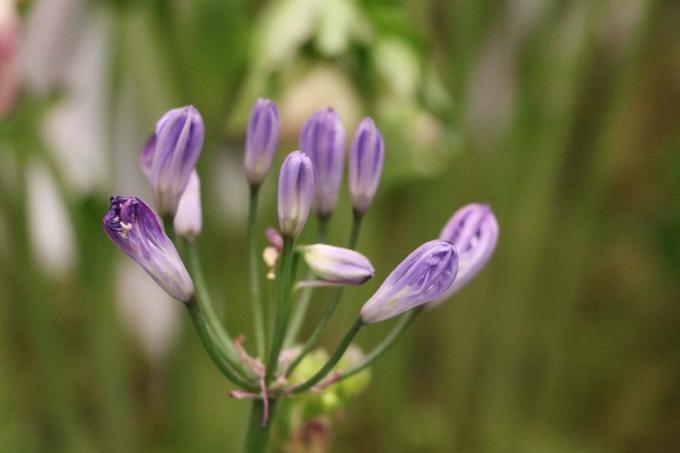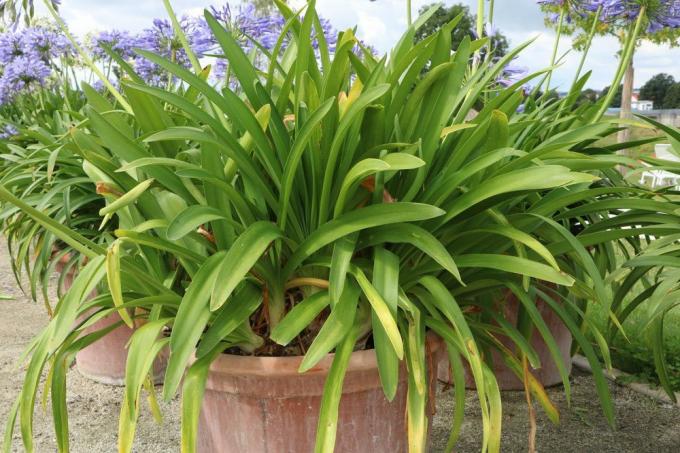
table of contents
- causes
- Location
- Planter
- Multiply
- wintering
- Nutritional deficiency
- Seed formation
Ornamental lilies (agapanthus), also known as love flowers, are a genus of the amaryllis family. They exist as evergreen and also as leg-shedding species. Its blue-white flowers grow at the end of long stems that appear much taller than the actual, rather inconspicuous plant. That's why it hurts all the more when the love flower doesn't bloom. Although the causes are relatively easy to determine, it often takes a lot of patience before the African Lily begins to bloom beautifully again.
causes
Causes and Solutions
There are several reasons why ornamental lilies fail to bloom. Fortunately, researching the cause of this behavior is relatively easy. The most common reasons for non-blooming are as follows.
- wrong location
- too large planter
- Multiplication by division
- wrong wintering
- Lack of nutrients in autumn
- Seed formation after flowering
If one or more reasons apply to the agapanthus, it will take a little patience until the measures take effect and the plant begins to bloom again.

Location
Agapanthi are originally from southern Africa. In their homeland, as in ours, they prefer a bright and sunny location. If the African Lily gets too little sun, it will stop or bloom. does not develop any flowers at all.
The ideal location for the plants is:
- full sun
- sheltered from the wind
For agapanthus to bloom magnificently, it needs at least half a day of sun. It is best to choose a location with an east or south orientation for the plant. The African Lily should also be protected from the wind so that its long flower stalks cannot break off in the wind. A place on the house wall is ideal as a sheltered location. This not only keeps the wind out, but also gives the plant additional warmth.
Tip: Also make sure that the agapanthus is not shaded by other plants or garden furniture. Since the plant itself is small, it can also be placed upright so that it gets enough sun.
Planter
Since most Agapanthi do not survive the German winter outdoors, they are mainly cultivated as container plants in this country. In contrast to many other potted plants, the size of the planter of the African Lily can influence the development of flowers. Does agapanthus or his roots have a lot of space in the bucket, his primary goal is to fill it with his roots. The plant neglects the formation of flowers. Flowers are only formed again when the planter is well rooted. So that the plant puts its energy into the formation of flowers, the planter should be designed as listed below.
- be as tight as possible
- too late rather than too early
A general guideline for the size of the planter is: The distance between the root ball and the edge of the tub should be a maximum of two centimeters. Since Agapanthi do not like repotting at all and punish them with non-or only sparse flowering, the plant should be repotted as rarely as possible.

Tip: The best and only time to repot is in spring.
Since the African Lily is very tight or stands very close to the planter, the roots exert enormous pressure on the planter. Therefore, valuable ceramic pots are not recommended for the plants, because cracks can easily occur. In addition, repotting the plant is often only possible by destroying the planter.
Multiply
Multiplication by division
Large ornamental lilies should be divided in the course of repotting. This stimulates growth. However, the division is often accompanied by a lack of flowers. If the plant has been divided, it may well happen that it does not bloom again until the third year after the division.
wintering
Agapanthi have to spend the German winter indoors. The open-air season for ornamental lilies ends in late autumn, in any case before the first frost. In order for them to bloom in the coming spring, the winter quarters must be light and cool. If it is too dark or warm, the plants will not develop flowers because they cannot produce enough growth energy.
The optimal temperature of the winter quarters should be between five and a maximum of ten degrees Celsius. The following applies to brightness: the warmer the winter quarters, the more light the plant needs. A light value of 1,500 to 2,000 lux is ideal.
Tip: Ten degrees Celsius is the maximum upper limit for winter quarters. Under no circumstances should the temperature be higher, not even slightly.
Further maintenance measures during the winter rest are:
- not pour
- do not fertilize
Cast or Fertilization is only started again when the plant begins to grow in spring. At this point, you can also remove the dead leaves from the previous year.
The open-air season begins for the agapanthus when no more frosts are to be expected. Since ornamental lilies should go outside as early as possible, they can, depending on the weather, move to the balcony or terrace as early as the beginning of April. If late frosts set in at short notice, the plants can be brought back into the warm or covered with a protective fleece.

Tip: Choose a cloudy day for the beginning of the outdoor season, as the plant has to slowly get used to the sun's rays again. If it gets too much sun too quickly, sunburn can occur on the leaves.
Nutritional deficiency
In order for Agapanthi to bloom again in the coming year, they must also be supplied with nutrients in autumn. A conventional complete fertilizer that is added to the irrigation water is completely sufficient for this. So the earth has to be kept moist even in autumn. In addition, the plants should be fertilized once a month in autumn.
If the plant was not supplied with enough nutrients in autumn, it will not develop any flowers in the following year. This care mistake can only be corrected in the autumn of the following year through an appropriate supply of nutrients.
Seed formation
The formation of seeds is the natural reproduction of the African Lily. This is why the plant puts a lot of energy into seed formation, which is at the expense of the flower. To avoid this, be sure to cut off withered inflorescences.



